
Apilan and kotamara are two Malay nautical terms which refers to the structure on a vessel where the cannon is installed. This term is used especially on Malay ships and boats.

Apilan and kotamara are two Malay nautical terms which refers to the structure on a vessel where the cannon is installed. This term is used especially on Malay ships and boats.
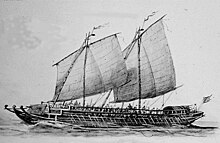
Apilan (or ampilan) [1] : 354 is the wooden gunshield found in Malay prahus where cannons are placed. It has a hole to place long gun, and sometimes swivel gun can be placed over the top of the apilan. Apilan is not permanent, it can be assembled, disassembled, and moved. [2] The crew of Malay prahu operated the long gun behind an apilan. The apilan usually situated at the bow of a prahu. [3] This gun-shield was only put on when the ship went into action. Sunting apilan is the name given to two lelas or light guns standing on the gun-shield of a heavy gun. [4]
Apilan is a true Malay word, it was not descended from any word. It is also a standalone word, due to the fact that the syllable is api-lan instead of apil-an. [5]

Kotamara is the breastwork or casement of Malay prahus. The function is to protect the gunner. Contrary to apilan, the kota mara cannot be moved. [2] It is the permanent bulwark of the battery in a Malay piratical ship. The term saga kota mara refers to a peculiar props keeping the gun shield (apilan) in position. The word benteng is also used for this permanent breastwork. Ambong-ambong are blocks of wood forming part of the framework of the battery in a Malay piratical perahu. These blocks support the base of the benteng. [4] The kota mara is already existed since at least the 8th century A.D., being shown in Borobudur ship bas relief. [6]
The term comes from Malay word kota which in turn comes from the Sanskrit word कोट्ट (kota) which means fort, fortress, castle, fortified house, fortification, works, city, town, or place encircled by walls. [7] The word mara may come from Malay word meaning "appear before", "forward", "come", [5] "moved to the front", "forward", and "advanced". [8] Thus it can be interpreted as "breastwork before a cannon" or "breastwork at the front". According to the Great Indonesian Dictionary (KBBI), kota mara means (1) Wall on a ship to protect men mounting the cannon (2) Terrace or wall over a castle which a cannon is mounted. [5] According to H. Warington Smyth, kota mara means transverse deck bulkhead at stem and stern (of a ship). [9] Benteng itself means fort, battery, or redoubt. [4]

Singapore resident John Crawfurd recorded Malay piracy near Singapore waters. The Malay pirate ships of the time were 40–50 feet (12–15 m) long with 15-foot (4.6 m) beam. The decks were made of split nibong wood. Smaller pirate craft put up thick plank bulwarks [apilan] when fighting, while larger ones like those of the Lanun people had bamboo ledges hanging over their gunwales, with a protecting breastwork [kota mara] of plaited rattan about 3 feet (0.91 meters) high. A crew might consist of 20-30 men, augmented with oarsmen of captured slaves. Small craft would have nine oars per side; larger ones would be double-banked, with an upper tier of oarsmen seated on the bulwark projection hidden behind rattan breastwork. Pirate armament included a stockade near the bow, with iron or brass 4-pounders, and another stockade aft, generally with two swivel guns. They also might have four or five brass swivels, or rantaka, on each side. They have bamboo shields, and were armed with spears, keris, muskets and other firearms they could get. [10]
H. H. Frese description of personal ship of the Sultan of Riau from 1883: [11]
This fast and impressive ship is heavily armed to fend off pirates, a real danger at that time. Two heavy muzzle-loading brass guns mounted on carriages are placed on the foredeck pointing forward. A heavy shield, or apilan, for the protection of the gunners, is constructed of horizontal beams for which fresh wood had to be used to prevent dangerous splintering when hit by a ball or bullet.
— The Mariner's Mirror
Lieutenant T.J. Newbold record about the Malay pirate prahu: [3]
The prahus used by Malay pirates are from eight to ten tons burthen, extremely well manned and remarkably fast, particularly with the paddles commonly used. They are generally armed with swivels on their bows, centre, and stern, of small calibre, but long range. When preparing to attack, strong bulwarks of wood called Apilans are erected, behind which the crew ensconce themselves, fighting with their long guns until their prey is disabled; or till the gong sound the signal for boarding.
— Journal of the Asiatic Society of Bengal, Volume 5
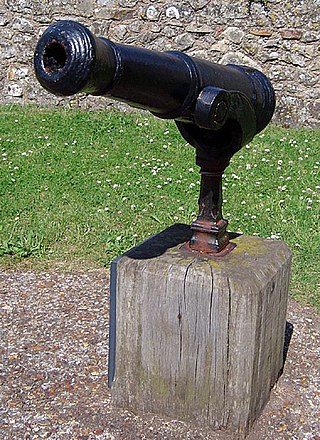
The term swivel gun usually refers to a small cannon mounted on a swiveling stand or fork which allows a very wide arc of movement. Another type of firearm referred to as a swivel gun was an early flintlock combination gun with two barrels that rotated along their axes to allow the shooter to switch between rifled and smoothbore barrels.
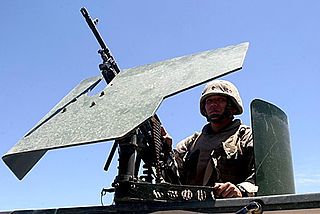
A gun shield is a flat piece of armor designed to be mounted on a crew-served weapon such as a machine gun, automatic grenade launcher, or artillery piece.

The Lantaka also known as rentaka was a type of bronze portable cannon or swivel gun, sometimes mounted on merchant vessels and warships in Maritime Southeast Asia. It was commonly equipped by native seafaring vessels from the Philippines, Indonesia, Brunei, and Malaysia. Lela and rentaka are known by the Malays as meriam kecil, the difference is that rentaka is smaller in length and bore than a lela. and Lantakas are often called Kanyon in Filipino.

Literally, the word pinisi refers to a type of rigging of Indonesian sailing vessels. A pinisi carries seven to eight sails on two masts, arranged like a gaff-ketch with what is called 'standing gaffs' — i.e., unlike most Western ships using such a rig, the two main sails are not opened by raising the spars they are attached to, but the sails are 'pulled out' like curtains along the gaffs which are fixed at around the centre of the masts.

The Battle off Mukah was a naval engagement fought in May 1862 between boats of the Sarawak and pirates. After the kidnapping of Sarawakian citizens some time before, two small gunboats encountered the pirates off Mukah on the northern coast of Borneo. In an unusual action, the Rajah Muda, Captain John Brooke, then the heir apparent to be White Rajah of Sarawak, led his force in the defeat of six pirate ships and the rescue of captured civilians.
Cetbang were cannons produced and used by the Majapahit Empire (1293–1527) and other kingdoms in the Indonesian archipelago. There are 2 main types of cetbang: the eastern-style cetbang which looks like a Chinese cannon and is loaded from the front, and the western-style cetbang which is shaped like a Turkish and Portuguese cannon, loaded from the back.
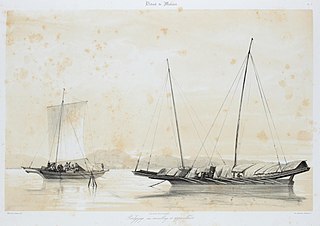
Penjajap, also pangajava and pangayaw, were native galley-like warships used by several Austronesian ethnic groups in maritime Southeast Asia. They were typically very long and narrow, and were very fast. They are mentioned as being used by native fleets in Indonesia, the southern Philippines, Malaysia, and Brunei.

Padewakang were traditional boats used by the Bugis, Mandar, and Makassar people of South Sulawesi. Padewakang were used for long distance voyages serving the south Sulawesi kingdoms.

A chialoup was a type of sloop used in the East Indies, a combination of western (Dutch) and Nusantaran (Indonesian) technologies and techniques. Many of these "boat-ships" were produced by VOC shipwrights in Rembang and Juwana, where the majority of the workers were local Javanese. Chialoups were used by the Dutch East India Company and private merchant-sailors of western and Nusantaran origin.

Perahu Mayang or simply mayang is a type of fishing boat from Java, Indonesia. This type of boat is used mainly for fishing and trading. Historically, this indigenous vessel is also favored by European skippers and private merchants for trading in East Indies: 50% of them were using mayang and pencalang. It is mostly used in northern coast of Java. The major production site is in Rembang, Central Java.

Benawa or banawa is a type of ship from Gowa, an old principality in the southwest corner of Sulawesi, Indonesia. The earliest record of this vessel is from Hikayat Banjar, which was written in or not long after 1663. In the present, this vessel is already extinct; being replaced by vessels with a similar hull, namely palari and padewakang.

Pelang or pilang is a traditional boat from Indonesia and Malaysia. It may refer to several different types of boats in the Nusantara, but commonly they refer to an outrigger canoe. The function differs from where they were used, from transporting people, fishing, to trading. Pilang has been known from at least the 14th century.

Kottamara is a type of floating battery or fortified raft from Borneo. It is used by native Bornean in warfare, its usage rose prominently during the Banjarmasin war (1859–1906). Kotta mara is used in riverine warfare, as an armed vessel or simply a blockhouse or fortification to prevent enemy advance in the river.

Bangkong is the war boat of dayak people, notably used by sea dayaks of Indonesia, Malaysia and Brunei. They are used for riverine warfare in Borneo, but they are also capable of sailing across the sea.

Ghurab or gurab is a type of merchant and warship from the Nusantara archipelago. The ship was a result of Mediterranean influences in the region, particularly introduced by the Arabs, Persians, and Ottomans. For their war fleet, the Malays prefer to use shallow draught, oared longships similar to the galley, such as lancaran, ghurab, and ghali. This is very different from the Javanese who prefer long-range, deep-draught round ships such as jong and malangbang. The reason for this difference is that the Malays operated their ships in riverine water, sheltered straits zone, and archipelagic environment, while the Javanese are often active in the open and high sea.
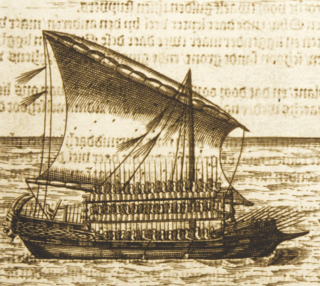
Ghali, gali, or gale are a type of galley-like ships from the Nusantara archipelago. Several native galley-like ships already existed in the archipelago, some with outriggers. The design of ghalis is the result of the impact made by Mediterranean shipbuilding techniques on native shipbuilding, introduced particularly by Arabs, Persians, Ottoman Turks, and Portuguese. The terms may also refer to Mediterranean vessels built by local people, or native vessels with Mediterranean influence.

Istinggar is a type of matchlock firearm built by the various ethnic groups of the Maritime Southeast Asia. The firearm is a result of Portuguese influence on local weaponry after the capture of Malacca (1511). Before this type of gun, in the archipelago already existed early long gun called bedil, or Java arquebus as the Chinese call it. Most of the specimens in the Malay Peninsula are actually Indonesian in origin, manufactured in the Minangkabau lands of West Sumatra. The states of the Malay Peninsula imported this firearm as it was widely used in their wars.

Bedil is a term from Maritime Southeast Asia which refers to various types of firearms and gunpowder weapons, from small pistols to large siege guns. The term bedil comes from wedil and wediluppu in the Tamil language. In their original form, these words refer to gunpowder blast and saltpeter, respectively. But after being absorbed into bedil in the Malay language, and in a number of other cultures in the archipelago, that Tamil vocabulary is used to refer to all types of weapons that use gunpowder. The terms bedil and bedhil are known in Javanese and Balinese, in Sundanese the term is bedil, in Batak it is known as bodil, in Makasarese, badili, in Buginese, balili, in Dayak language, badil, in Tagalog, baril, in Bisayan, bádil, in Bikol languages, badil, and in Malay it is badel or bedil.

Lela or lila is a type of Malay cannon, used widely in the Nusantara archipelago. They are similar to a lantaka but longer and had larger bore. Lela can be configured as swivel gun, fixed gun, or mounted in a gun carriage. It is the equivalent of European falcon and falconet.

A lancang is a type of sailing ship from Maritime Southeast Asia. It is used as warship, lighter, and as royal ship, particularly used by the people of Sumatran east coast, but can also be found in the coast of Kalimantan.
{{cite journal}}: Cite journal requires |journal= (help)